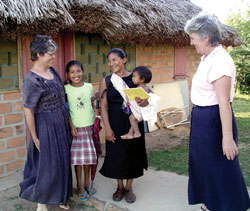I Hear the Bonging of the Drum
Accompanying the Wapishana people who lead a hard yet simple life in Guyana's interior
By Barbara White
May 2005
Return to Table of Contents
Print Article
Aishalton is one of the many remote Amerindian villages scattered throughout the interior of Guyana. It is located about 100 miles south of Lethem in the savannah area. Its picturesque setting, nestled among low-lying mountains, allows a clear unobstructed view of the brilliant stars overhead and the spectacular sunsets.

Throughout the village, narrow foot or bicycle paths run helter-skelter to and from thatched roof homes. Although some villagers have bicycles, walking is the main means of transportation. Many of the homes consist of one room with an array of hammocks, enough for the entire family, slung across for sleeping. The walls and floor are made of local clay or brick. Other furniture may include a pole for hanging clothes, and perhaps a bench or small table.
Each home has an outdoor cooking area, either as a lean-to or a separate building. Other outbuildings include a toilet and a small thatched enclosure used for bathing, although many villagers bathe and do their laundry in nearby creeks. Some of the more well-off villagers have houses made of wood with galvanized roofs and individual rooms. There is no electricity, no phones and no running water.
Water always presents a problem as creeks or wells become polluted or dry up. Drinking water is collected from dug wells or holes and usually carried long distances-a burdensome chore for the women and children.
The Amerindian peoples in Aishalton are mainly of the Wapishana tribe. These quiet, passive people live very simply. For most, each day consists of tending and watering their farms, fetching water for laundry and washing, chopping and hauling wood for their cooking fires, harvesting their crops of fruits and vegetables, fishing and other activities necessary for life. Women do much of the hard labour.
Farms are located outside the village, sometimes long distances away, and farming is done with simple tools and methods. The people are dependent on the rain to water their crops or else they carry water by bucket from creeks or wells. They grow foods necessary to their diet, such as cassava, edo, plantain, sweet potatoes, rice and peanuts.
Fruit trees are abundant and we enjoy such fruit as mangoes, papaya, grapefruit, oranges, limes and cashews. The diet consists mainly of starchy foods with a few green vegetables, some beans, and meat when it is available.
Church is an integral part of the people's lives-a place to meet and visit with friends and to get caught up on village news. Communication is by word of mouth and announcements are made at churches and other gatherings.
Each morning at five o'clock, the bonging of a drum awakens the entire village. The drum also announces a death or a holiday, and calls people to village work, even telling the number of people required. Although we do not yet know the meaning of all the bongs, we do hear them loud and clear, as the drum is located just at the corner of our house.
The indigenous language, Wapishana, is under threat as people of other languages move into the area and only English is taught in the schools. Aishalton has three schools: a nursery school, elementary and secondary school. The secondary school has a dormitory attached, which enables children from distant villages to attend. Although schooling is free for all children in Guyana, many do not attend because of the difficulty and expense of getting to school. Many children, from an early age, end up staying at home or seeking jobs on farms or in the gold mines.
Since coming to Aishalton, Maxine and I have been involved in many different activities. Maxine teaches sewing and other crafts such as weaving and pottery. The women have a keen interest in learning these skills.
I am involved in the medical field, looking after little aches and pains, visiting the sick and elderly and assisting at clinics in the hospital. Although Aishalton has a reasonably well-equipped hospital, there is no doctor here.
We are also involved in religious education of adults and children and operate a small lending library. We hold sessions for a group of unmarried mothers to assist them in learning parenting and other skills associated with daily living.
These young women have worked hard getting a plot of land ready to grow a garden. We hope that they will eventually be able to grow their own food. Growing a garden is a most difficult task because of the limited access to water and the basic farming methods used. For instance, to obtain fertilizer we roamed the fields picking up cow chips, which were then thrashed into dust using heavy poles. After sifting it through their fingers the women spread the fertilizer over the garden using pieces of cardboard or gunnysacks. Hopefully we'll be getting some produce soon.
The people here face many challenges. Although the community has food and shelter, these may be inadequate and the means of obtaining them is often back breaking work. There is also alcoholism and all that goes with it, teenage pregnancy and youth uninterested in working the land. Young people are no longer content to stay in the village and work the farms as their families do. They would rather seek an easier way of life, and are lured by the life they see and hear about in other parts of the country.
Maxine and I do what we can to help in the village, but I feel that our biggest contribution to the people is the fact that we are here-willing to share their heartaches, struggles and joys. We in turn have learned the beauty of a simple way of life, away from noise, pollution and hustle bustle. We are gaining a greater appreciation of the more important things in life.
Return to Table of Contents
Print Article